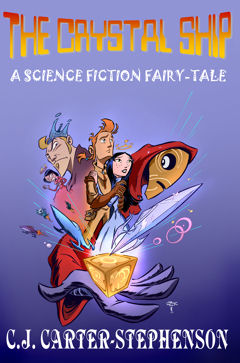C. J. Carter-Stephenson, The Crystal Ship
reviewed by Steve Douglas

The Crystal Ship Publisher: Bonito Books, 2010 Length: 114 pages ISBN: 978-1-4457-1369-4 |
Thanks to an independent-minded grandmother I had started reading at the age of four-and-a-bit. She felt it was unwarranted coercion that no one would read me the Sunday comics in the newspaper, unless I went to Sunday school first. Of course, her teaching text was the Bible (King James version) so my spiritual needs weren’t neglected after I declared I wasn’t going to Sunday school any more. A blow for independence was thus struck, and I never looked back.
Don’t get me wrong, it wasn’t all spaceships and blasters. I was and am an omnivorous reader. Adventure, mystery, western, fantasy, all were grist for the mills of my mind. Even today, I hunt down my old childhood favorites in used bookstores, garage sales and online.
Many will recall those names. Stephen Meagher, Howard Pease, Joseph Atschuler, and the series production lines of the Hardy Boys and Rick Brant. (OK, and occasionally a Nancy Drew.) No classics were neglected, and I still have my first copies of The Black Arrow and Kidnapped. Stevenson and Scott are still friends after fifty years. Throw in Enid Blyton and Edith Nesbit for leavening and you have an incredible hodge-podge of stuff that any intelligent child would devour if given half a chance.
The Crystal Ship is a charming little book for the 9-12 age group, or even younger. It strikes me as an excellent transition from fairy tale to hard science fiction. I particularly liked the black and white drawings inserted every few pages. Our poor but hard-working young hero (who isn’t afraid to use his brain), a beautiful Princess in suspended animation, A Prince of the Fairfolk (an alien race, half human-sized, green, with transparent wings) and of course, the AI-operated, thought-interfaced Crystal Ship.
I liked the hero farm-boy-cum-starship pilot because he actually tries to think his way through problems instead of charging in with Delameters blazing. (Did I mention he isn’t afraid to use his brain?) He’s not afraid to throw the dice in a tight situation, either. The Princess is everything she should be also, sweet, intelligent (for a given value of intelligence), and not totally helpless. A bit twee perhaps, but that’s allowable in a book for the younger age group.
We open with a lonely King, looking for his perfect Queen. Mighty in war, well-liked by his people, but he still hasn’t found the perfect woman and is despondent. The story of the beautiful Princess, the nice half of a pair of twins, disappeared by her nasty sibling, sounds like just the girl for him. Carried off by the Fairfolk, the Princess ends up in suspended animation in a lifepod after an attack on the Fairfolk ship, which was destroyed.
For a thousand years, the lifepod has been lost in space. Struck by the tale, The King decides to recruit a hero to find the princess and bring her back to be his bride. (What a marvelous title for a story, The Princess Bride! What? Oh, such a pity.)
The hero-selecting process is a bit different. Defeat a dragon, but by thinking, not brawling. Our hero wins the right to rescue the princess and embarks on a number of adventures featuring various ruses and brainpower to finally find and rescue the Princess.
During the triumphant return, our hero and heroine fall madly in love, so when the King sells out the princess as a matter of political expediency, another timely ruse by our hero reunites him with his true love. They more or less steal the Crystal Ship and escape for a lifetime of adventures among the stars.
As a life long fan of children’s fiction, I feel this is a fine starter book for anyone wanting to start out a new reader in SF. It’s also an excellent bedtime story if read a chapter a night. Just don’t be surprised when you leave it in the child’s room to find their consumption of flashlight batteries goes up. Oh, ignore those odd sounds from the bedroom after lights out, too.
This is a romance story, in the old classical meaning of the word romance. Sabatini would call it such, and so would Robert Louis Stevenson, although they wrote for older age groups. To sum up, buy this book. I expect to see this author’s name again, and I look forward to it.
Copyright © 2010 by Steve Douglas

